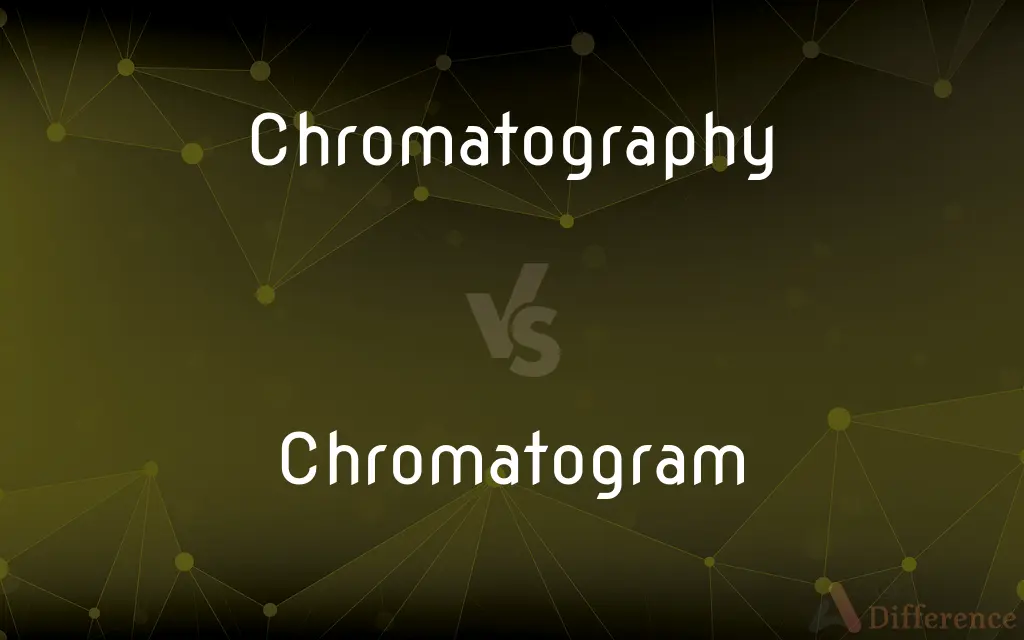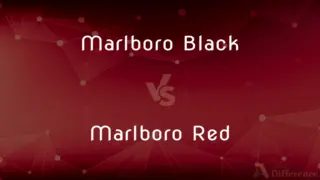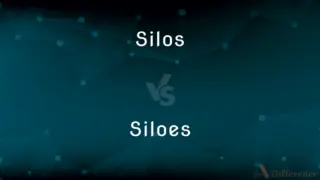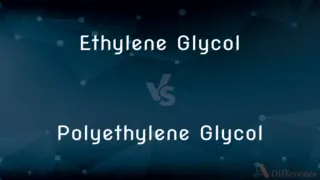Chromatography vs. Chromatogram — What's the Difference?
Edited by Tayyaba Rehman — By Fiza Rafique — Updated on May 2, 2024
Chromatography is a method for separating mixtures based on their molecular composition, while a chromatogram is the output or visual result of a chromatography experiment, displaying the separated components.

Difference Between Chromatography and Chromatogram
Table of Contents
ADVERTISEMENT
Key Differences
Chromatography refers to a set of laboratory techniques used for the separation of mixtures. It involves passing a mixture dissolved in a "mobile phase" through a "stationary phase" to separate the substances based on differential adsorption. Whereas, a chromatogram is the graphical representation or actual physical result that shows how the different chemicals in the mixture were separated.
In the process of chromatography, the substances that make up a mixture move at different speeds, causing them to separate from each other. On the other hand, a chromatogram visually records this separation, showing peaks or bands that correspond to different substances.
The role of chromatography extends beyond just separation; it is also used for purification and identification of substances. A chromatogram, however, primarily serves as a diagnostic tool to analyze the outcome of the chromatography process.
Various types of chromatography, such as gas chromatography or liquid chromatography, utilize different mechanisms and stationary phases. Each type yields a chromatogram that may look distinct and contain different information about the substances analyzed.
While chromatography is a dynamic process involving the interaction of physical substances, a chromatogram is a static outcome that provides data, which can be analyzed further to understand the properties and concentrations of the components involved.
ADVERTISEMENT
Comparison Chart
Definition
A technique used to separate mixtures based on the molecular characteristics of the components.
The graphical output or record of a chromatography process.
Purpose
To separate, identify, and purify components within a mixture.
To visually depict the separation and facilitate analysis of the components.
Nature
Process
Result
Types
Gas, liquid, paper, thin-layer, etc.
Depends on the type of chromatography used; typically a graph or a series of bands.
Usage in Science
Used in chemical analysis, biochemistry, and forensic science.
Used to analyze and interpret the results of chromatographic separation.
Compare with Definitions
Chromatography
A method for separating and analyzing compounds in a mixture.
The lab used chromatography to separate the various pigments in the sample.
Chromatogram
A graph where the x-axis often represents time and the y-axis the detector response.
In the chromatogram, the time to peak was used to identify the substance.
Chromatography
A process applicable in multiple fields like pharmacology, environmental testing, and food safety.
Chromatography plays a crucial role in testing food additives for safety.
Chromatogram
A result that can be used to quantify the amount of substances present.
From the chromatogram, they calculated the percentages of each component in the blend.
Chromatography
A fundamental tool in chemical analysis for identifying substances.
Gas chromatography is especially useful for volatile organic compounds.
Chromatogram
A visual output showing the separation of mixture components.
The chromatogram displayed distinct peaks for each aromatic compound.
Chromatography
A technique involving a mobile phase and a stationary phase to isolate substances.
They optimized the chromatography process to improve the purity of the final product.
Chromatogram
A tool for comparing the presence of substances between samples.
By comparing chromatograms, they detected the impurity that was absent in the control sample.
Chromatography
Used for both qualitative and quantitative analysis.
Quantitative chromatography was employed to measure the concentration of pollutants.
Chromatogram
An essential part of documentation in analytical chemistry.
The chromatogram was attached to the lab report as proof of the analytical procedure.
Chromatography
Any of various techniques for the separation of complex mixtures that rely on the differential affinities of substances for a mobile (gas or liquid) medium and for a stationary adsorbing (liquid or solid) medium through which they pass, such as paper, gelatin, or silica.
Chromatogram
The pattern of separated substances obtained by chromatography.
Chromatography
Chromatography is a laboratory technique for the separation of a mixture. The mixture is dissolved in a fluid (gas or solvent) called the mobile phase, which carries it through a system (a column, a capillary tube, a plate, or a sheet) on which is fixed a material called the stationary phase.
Chromatogram
(analytical chemistry) The visual output from a chromatograph. Usually a graphical display or histogram.
Chromatography
(analytical chemistry) Any of various techniques for the qualitative or quantitative separation of the components of mixtures of compounds; all characterised by the use of a mobile phase (gas or liquid) moving relative to a stationary phase (liquid or solid) – the differences between the rates of migration of the compounds between the two phases effects the separation.
Chromatogram
The paper strip, column, gel, or TLC plate on which subsances have been separated by a process of chromatography{2}.
Chromatography
A treatise on colors
Chromatogram
The record of the results of a process of chromatography{2}, produced by an instrument which measures some property related to the concentration of substances over the course of a chromatographic process. The record may be printed, for example, on a piece of paper, showing the concentration of some substance as a function of time or volume; or it may be retained in a computer and displayed on a video display terminal.
Chromatography
An analytical and preparative technique for separating substances by differences in their selective adsorption to solids, by passing a liquid over the solid, to which the substances to be separated have usually been adsorbed in a preliminary step. The major variations are column chromatography, in which the substances to be separated are adsorbed to a column with any of a wide variety of adsorbing solids in powdered or granulated form; paper chromatography, in which the solids are applied as a spot at one end of a strip of absorbent paper (such as filter paper), and the liquid is percolated through the paper by capillary action; and thin-layer chromatography (TLC), which is similar to paper chromatography, but the adsorbent material is, instead of paper, a thin layer of finely powdered material, such as cellulose or silica, on a backing of glass or plastic, called a TLC plate. A modern version of column chromatography is high-performance liquid chromatography, usually referred to as HPLC.
Chromatogram
The recording (column or paper strip) on which the constituents of a mixture are adsorbed in chromatography
Chromatography
A process used for separating mixtures by virtue of differences in absorbency
Common Curiosities
What is chromatography used for?
Chromatography is used for separating, identifying, and purifying chemical substances within a mixture.
What does a chromatogram show?
A chromatogram shows how substances in a mixture have been separated, typically displaying peaks or bands representing different components.
Can a chromatogram be used to identify unknown substances?
Yes, by comparing the chromatogram to known standards, unknown substances can often be identified.
What are the key components of a chromatography setup?
The key components include a mobile phase, a stationary phase, a column, and a detector.
What types of chromatography are there?
There are several types, including gas chromatography, liquid chromatography, and thin-layer chromatography, each suitable for different kinds of samples.
How do you read a chromatogram?
A chromatogram is read by analyzing the retention time and size of peaks, which correspond to different substances in the sample.
Why is chromatography important in pharmaceuticals?
It is critical for the purity analysis and quality control of drugs.
Is chromatography expensive?
The cost can vary widely depending on the type of chromatography and the complexity of the analysis.
Can chromatography separate any mixture?
While very versatile, chromatography may not be suitable for all mixtures, especially those with very similar physical and chemical properties.
How are chromatography and a chromatogram related?
Chromatography is the process, and a chromatogram is the visual or recorded result of this process.
How do environmental scientists use chromatography?
They use it to detect and quantify pollutants in water, air, and soil.
Can chromatography be automated?
Yes, many modern chromatographic techniques are automated to increase throughput and reproducibility.
What does a peak represent in a chromatogram?
Each peak represents a different component of the mixture that has been separated in the chromatography process.
How is a chromatogram used in forensic science?
In forensic science, chromatograms help identify substances such as drugs, toxins, and explosives in samples.
What safety precautions are necessary when conducting chromatography?
Safety precautions include using proper ventilation, handling chemicals with care, and wearing appropriate protective equipment.
Share Your Discovery

Previous Comparison
Concrete vs. Tangible
Next Comparison
Compiler vs. ParserAuthor Spotlight
Written by
Fiza RafiqueFiza Rafique is a skilled content writer at AskDifference.com, where she meticulously refines and enhances written pieces. Drawing from her vast editorial expertise, Fiza ensures clarity, accuracy, and precision in every article. Passionate about language, she continually seeks to elevate the quality of content for readers worldwide.
Edited by
Tayyaba RehmanTayyaba Rehman is a distinguished writer, currently serving as a primary contributor to askdifference.com. As a researcher in semantics and etymology, Tayyaba's passion for the complexity of languages and their distinctions has found a perfect home on the platform. Tayyaba delves into the intricacies of language, distinguishing between commonly confused words and phrases, thereby providing clarity for readers worldwide.
















































